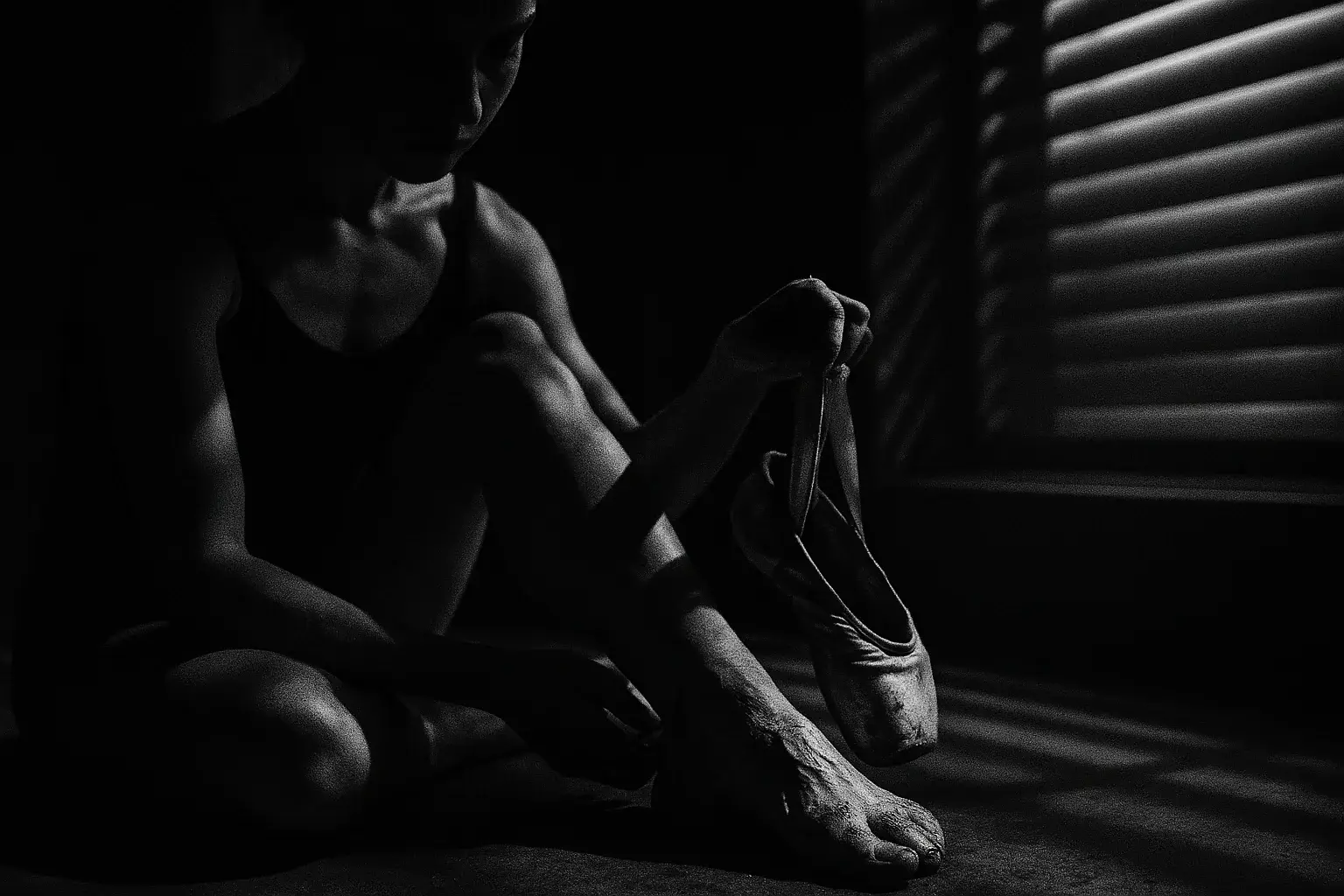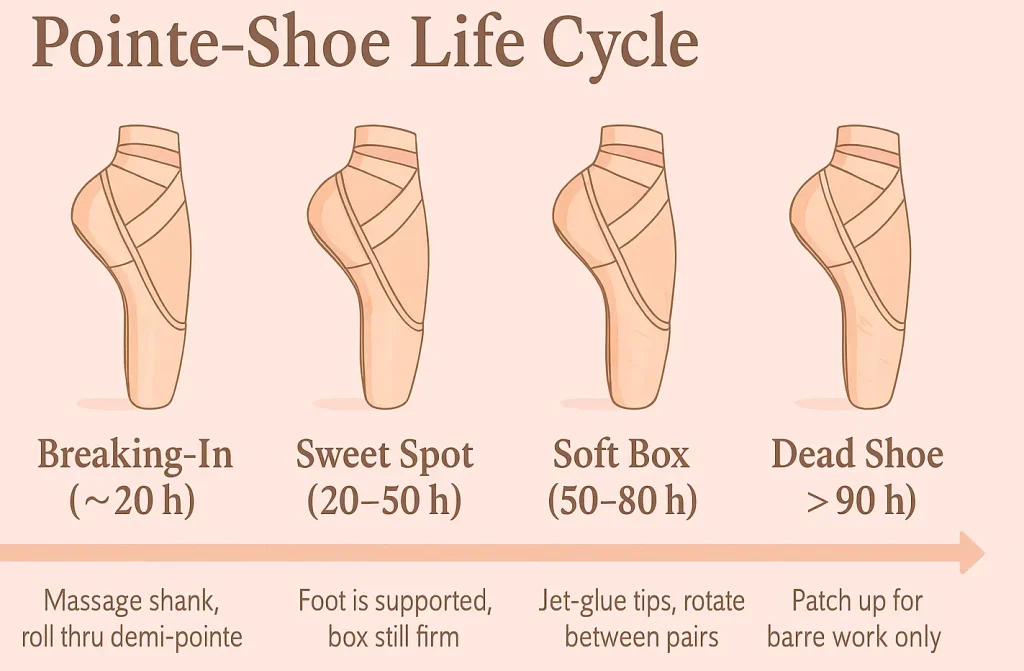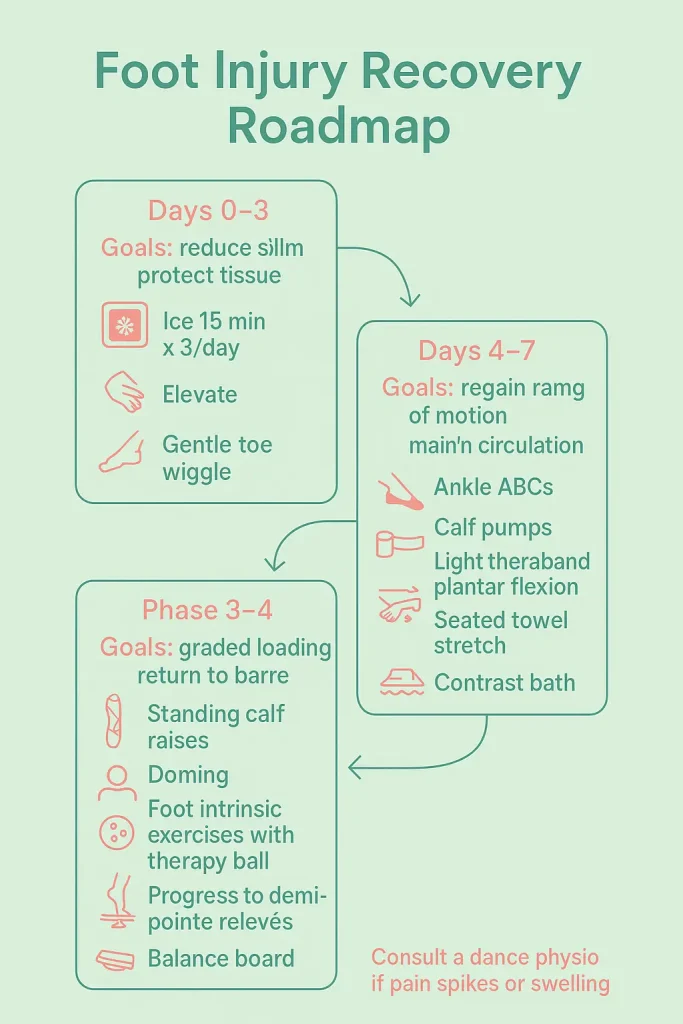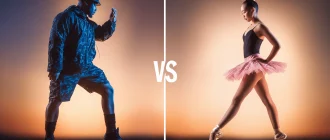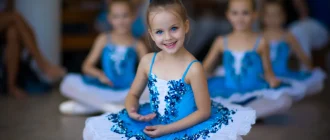Ballet dancers often face severe foot injuries, known as ballerina foot damage, due to the intense demands of their craft on a ballerina’s body weight or a dancer’s ankle and feet. This article explores the common types of ballet shoes, their potential to cause foot injuries, and essential preventive measures.
Graceful Insights
- Ballet training places significant stress on dancers’ feet, leading to injuries and long-term damage, especially when compounded by poor technique and inadequate recovery.
- Pointe shoes play a critical role in a dancer’s foot health; a proper fit is essential to minimize injuries related to pressure and excessive movement within the shoe.
- Early recognition of foot damage symptoms, combined with preventive measures such as strengthening exercises and regular professional check-ups, is vital for maintaining foot health and performance in ballet.
Ballerina Feet Damage Podcast
Ballerina Foot-Injury Quick-Reference
| Injury | Self-Care (OK if all these apply) | RED FLAGS – See a doctor NOW! |
|---|---|---|
| Blister / Callus | • Small, closed, clear fluid blister • No pus, spreading redness, or severe pain • Protect with a Moleskine, keep clean and dry, Mayo Clinic | • Pus, foul smell, or spreading redness • Fever ≥ 38 °C / 100 °F • Diabetic dancer or immune-compromised, Mayo Clinic |
| Bunion irritation | • Achy bump that settles with ice, wider shoes, toe-spacers • Pain < 48 h and improving Mayo Clinic | • Persistent or worsening pain • Big-toe joint is rigid or noticeably drifting • Shoes no longer fit the Mayo Clinic |
| Ingrown toenail | • Mild edge tenderness only • No drainage or spreading redness • Daily warm soaks + cotton lift help Mayo Clinic News Network | • Severe pain, pus, or swelling spreading beyond the nail • Fever, or a dancer has diabetes / poor circulation, Mayo Clinic News Network |
| Plantar fasciitis / Heel pain | • Morning “first-step” ache that eases with stretching, ice bottle, rest • Symptoms < 2 weeks and trending better, Mayo Clinic | • Sharp heel pain after an acute landing • Can’t push off, rise to relevé, or even experience pain at rest • Heel swollen, red, or hot, Mayo Clinic |
| Achilles tendinitis (over-use) | • Dull ache that warms up during barre • Improves after 2-3 days of R.I.C.E. and load modification, Mayo Clinic | • Sudden “pop” in back of ankle, inability to plantar-flex or stand en pointe → possible rupture • Severe swelling or calf weakness, Mayo Clinic |
| Ankle / Foot sprain | • Mild swelling, can bear weight and relevé with only slight discomfort • Pain subsides within 48 h of R.I.C.E., Mayo Clinic | • Can’t weight-bear, ankle looks deformed or very swollen • Numbness, pain directly over bone → possible fracture, Mayo Clinic |
| Stress fracture | — | Always needs medical imaging if you have: • Localized bone pain that worsens with every relevé/jump • Night or rest pain • Swelling over a metatarsal or navicular, Mayo Clinic |
How to use: If an injury meets only the left-column criteria, start home care (Rest, Ice, Compression/Taping, Elevation, anti-inflammatories, technique check). The moment any red-flag signs appear—or symptoms fail to improve inside the indicated window—stop dancing and consult a podiatrist, sports-medicine doctor, or physiotherapist experienced with dancers.
Understanding Ballerina Foot Damage
Ballerina feet damage refers to the physical toll that ballet training and performance place on a ballet dancer’s ballerina feet. The immense strength and coordination required from a ballet dancer’s feet can result in various foot injuries, especially when compounded by poorly fitting footwear, improper training, and intense performance schedules.
Indeed, the feet are often the most physically stressed part of a ballet dancer’s body, making them particularly susceptible to damage.
Incorrect pointe posture and excessive stress from various ballet positions can exacerbate foot problems. Poor pointe technique, both at the pointe work at the hip and knee level, further contributes to the damage, creating a cascade of issues that affect a ballerina’s feet. Moreover, insufficient recovery time between practices and performances often leads to overuse injuries, adding another risk for ballet-related foot injuries.
Recognizing the causes and risks associated with ballerina’s foot damage allows dancers to take proactive steps to mitigate these issues, keeping their ballerina’s feet strong and resilient throughout their careers.
The Impact of Pointe Shoes
Pointe shoes, crafted from materials like satin, leather, and cotton, are designed to support a dancer’s body weight while allowing them to perform on the tips of their toes. However, when a dancer is on point, the pressure exerted on the big toe box and the toe box alone can reach up to 220 psi (1.5 MPa), creating significant stress on the toes and leading to various foot injuries.
This intense pressure can cause visible changes in the feet, such as blisters, corns, and calluses, which are common among ballet dancers, highlighting the importance of proper pointe technique.
The structure and fit of pointe shoes are critical in preventing or exacerbating foot damage. Properly fitted pointe shoes minimize the risk of injuries and provide the necessary support for rigorous pointe work. Dancers must wear high-arch top shoes that fit tightly yet comfortably, without extra space, to avoid unnecessary movement that could cause blisters and other foot issues.
Common Foot Injuries in Ballet
Common foot injuries among ballet dancers include stress fractures, foot fractures, ankle sprains, and skin issues like blisters and bunions. These injuries often result from the physical demands on a ballerina’s feet.
They are usually the result of repetitive force and pressure from activities such as jumping and landing, which are integral to ballet. Stress fractures, also known as dancer’s stress fractures, are particularly prevalent due to the repeated stress and strain placed on the feet during these activities.
Plantar fasciitis is another common condition ballet dancers face, characterized by tissue inflammation on the bottom of the foot and ankle, leading to significant pain. Similarly, Achilles tendonitis arises from repeated, repetitive stress on the Achilles tendon, while Hallux rigidus affects the big toe joint, causing pain and limited movement. These conditions highlight the diverse range of injuries that can afflict a ballet dancer’s feet and ankles.
Recognizing the signs and symptoms of common injuries early allows dancers to seek appropriate treatment and adjust their technique or footwear, which can prevent further damage.
Long-term Effects on Feet
Continuous ballet training can cause the feet to change shape or become deformed over time, often called ‘ballet dancer’s feet.’ This transformation includes pronounced arches and dry, cracked soles. Such changes are not just cosmetic; they can lead to chronic foot problems that affect a dancer’s performance and quality of life.
These long-term effects underscore the importance of preventive measures and proper foot care while dancing ballet. Without adequate attention, the cumulative damage can result in debilitating conditions that may even end a dancer’s career.
Recognizing the potential long-term consequences of dancing ballet is vital for anyone involved in ballet.
Identifying Symptoms of Foot Damage
Early recognition of foot damage is crucial for a ballet dancer’s heel. Persistent pain, swelling, redness, and blisters can indicate various foot conditions that, if left untreated, may lead to more severe injuries. Pain and swelling are particularly important, as they signal underlying issues that need immediate attention.
A healthcare provider should evaluate unresolved pain that persists despite self-care measures. Early intervention can prevent more serious complications, and regular check-ups with a podiatrist can help monitor foot health and catch potential issues before they become more severe.
Pain and Swelling
Years of ballet training can cause significant changes in a dancer’s feet, often resulting in pain and swelling. Pain in the feet and heels can indicate plantar fasciitis, a common condition among ballerinas. Swelling in the feet can also signal other injuries, such as sprained ankles, which require close monitoring to prevent further damage.
Dancers should notice any symptoms that worsen after each dance routine or practice. Pain and swelling are early indicators of foot damage and should not be ignored. Prompt attention to these symptoms can help prevent chronic conditions and improve long-term foot health.
Difficulty Moving Toes
Difficulty moving the toes can signal nerve damage or joint issues. Nerve damage and stress fractures can impair muscle control, making movement difficult. If you experience significant swelling, bruising, or difficulty moving your foot, it is critical to seek immediate medical evaluation.
Visible Changes in Feet
Visible changes in the feet, such as bruising, bony protrusions, and malformations, are common signs of foot damage among ballet dancers. These changes often indicate underlying damage caused by the strains of ballet dancing. Recognizing these signs early can help dancers seek appropriate treatment and avoid long-term complications.
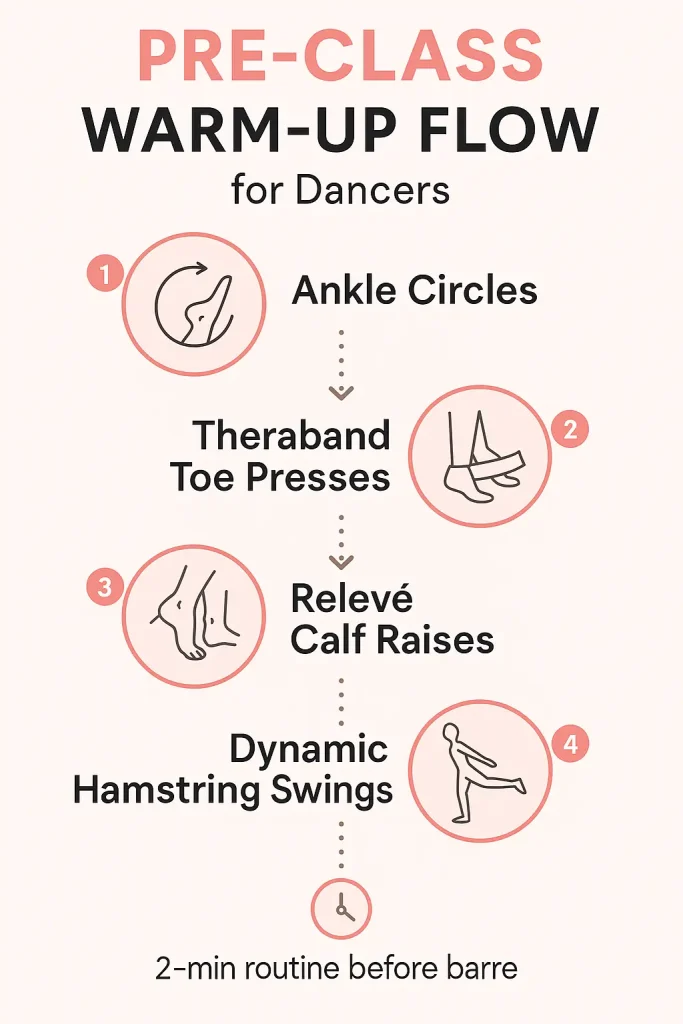
Preventive Measures for Ballerina Feet
Preventive measures are necessary for ballerinas to maintain healthy feet. Properly fitted ballet shoes can prevent injuries related to misaligned feet. Incorporating a stretching and strengthening routine can significantly lower the risk of foot injuries for ballet dancers.
Proper foot hygiene prevents infections and other complications. Using a pumice stone on the feet can help manage calluses formed by the pressure of dancing. These preventive measures protect dancers’ feet and enhance their overall performance.
Properly Fitted Pointe Shoes
Pointe shoes should fit tightly around the foot, allowing for toe movement without extra space inside the shoe. Many dancers recommend professional fittings to ensure the best results when choosing pointe shoes, as a proper fit can significantly reduce the risk of foot injuries. Dancers should communicate their body weight and comfort level to achieve an ideal fit during the fitting process.
Dancers should wear proper clothing that allows their toes and feet to be visible during fittings. They should also trim their toes and toenails beforehand to prevent discomfort and pressure on the toes and nail beds when dancing en pointe. These steps help achieve a snug fit, minimizing foot problems.
Strengthening Exercises
Strengthening exercises maintain the health and performance of a ballerina’s feet, significantly reducing the risk of common injuries such as stress fractures and Achilles tendinitis. Strengthening exercises include big toe up raises, ankle circles, and resistance band exercises.
Incorporating these exercises into your daily routine ensures consistent foot and ankle joint strength improvement. Regular practice also enhances endurance and stability, which are essential for preventing injuries.
Adequate Rest and Recovery
Adequate rest allows the feet to recover from the stresses of ballet dancing. Sufficient rest periods between practice sessions are crucial for foot health and help recover from minor injuries.
Taking significant breaks, ideally, two consecutive days, ensures proper recovery. This rest period allows muscles and tissues to heal, reducing the risk of chronic injuries.
Effective Treatments for Damaged Ballerina Feet
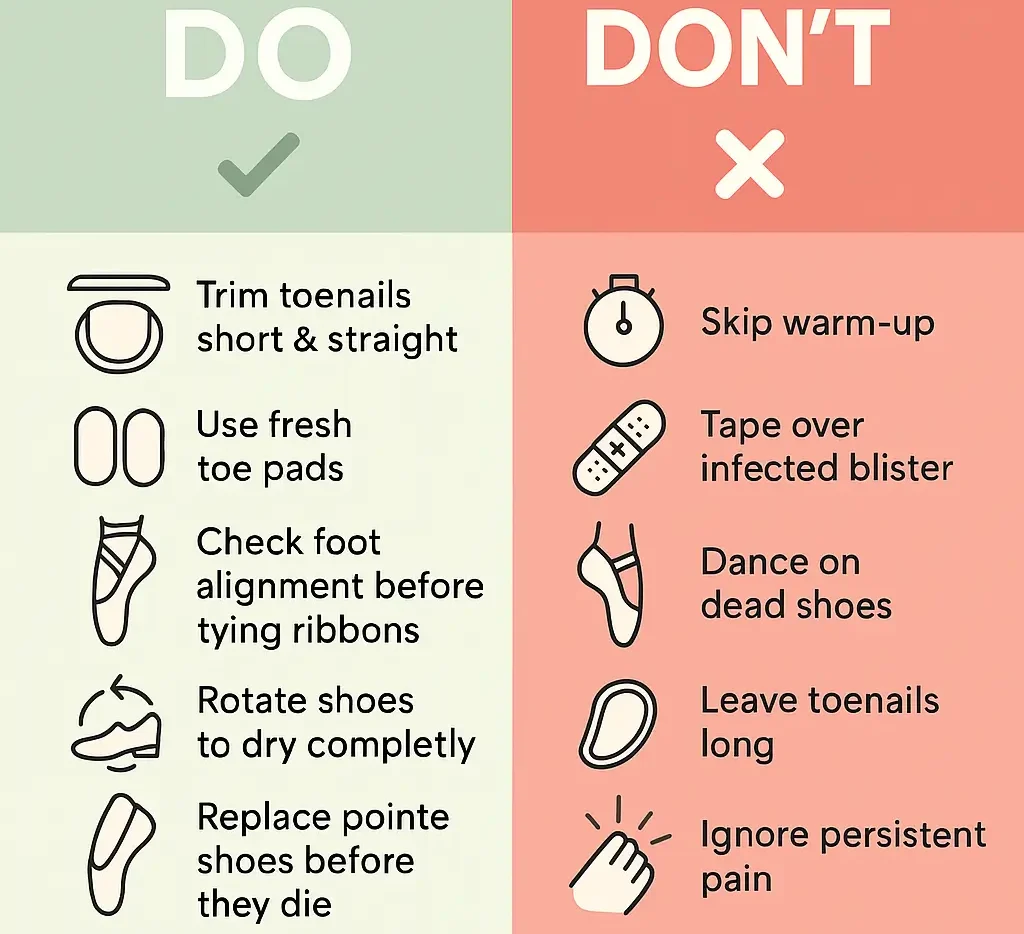
Treating injuries is crucial for maintaining foot health in ballet dancers. Early and appropriate treatment prevents permanent damage and ensures long-term foot health. Various treatment options are available, from immediate care for acute injuries to professional medical treatments and home remedies.
Understanding and applying these treatments allows dancers to manage foot and ankle injuries and prevent further complications effectively.
Immediate Care for Injuries
Applying ice to the affected area alleviates pain and swelling from acute foot injuries. Raising the injured foot and applying ice are critical first steps. Elevating the foot during recovery reduces swelling and promotes the healing process. These immediate care steps are crucial for reducing pain and promoting recovery.
Combining physical therapy, ice application, body weight, and foot elevation enhances recovery from acute injuries, preventing further damage and ensuring a quicker return to dancing.
Professional Medical Treatments
Ballet dancers should consult a podiatrist or orthopedic doctor specializing in dance medicine for foot care. Specialists can provide tailored treatments for ballet injuries, ensuring the best care. Custom orthotics may be prescribed to provide additional support and cushioning.
In severe cases, surgical intervention may be necessary to address significant injuries. Professional medical treatments are essential for managing chronic conditions and ensuring complete recovery.
Home Remedies and Self-Care
Using a pumice stone helps remove calluses and keep feet smooth. Regular foot hygiene can prevent fungal infections and other complications.
These home remedies and self-care practices are simple yet effective. They help manage foot health and prevent injuries.
When to Seek Professional Help
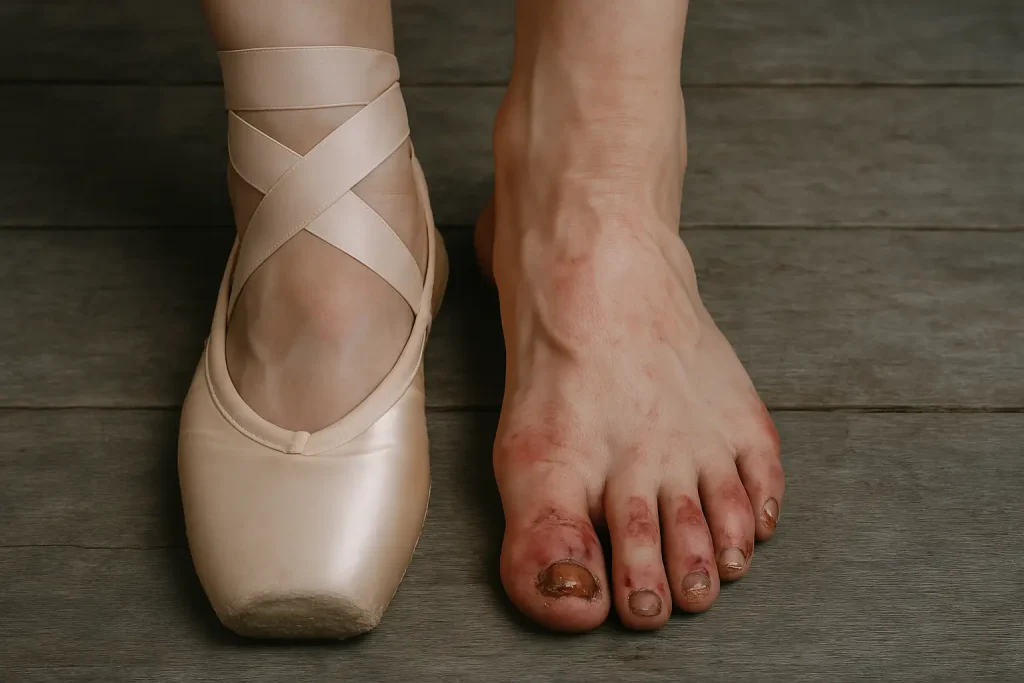
Consultation with a specialist and proper recovery steps are necessary for recovering from a foot or ankle injury. Chronic pain or severe symptoms require professional evaluation. Regularly assessing foot and ankle health can help catch potential issues early, preventing them from becoming severe.
Recognizing the signs that indicate the need for professional help ensures timely intervention and maintains foot health.
Persistent Pain
Persistent foot pain and swelling can indicate a serious condition, such as plantar fasciitis. Worsening symptoms require the attention of a healthcare provider or a physical therapist. Addressing persistent pain early can prevent more serious complications and improve foot health.
Dancers must take persistent pain seriously and seek professional help to avoid long-term damage. Early intervention significantly impacts managing foot health and preventing chronic conditions.
Severe Symptoms
Severe symptoms in the ballerina’s feet include chronic pain, significant swelling, or deformities that require professional evaluation. Chronic pain or deformities should prompt a visit to a podiatrist.
Immediate professional attention is necessary to address severe symptoms and prevent further complications.
Regular Check-ups
Routine visits to a podiatrist are essential for monitoring foot health and preventing serious issues among dancers. Regular podiatrist appointments can prevent serious conditions from developing.
Routine check-ups with a podiatrist are crucial for the early detection of foot issues and maintaining overall foot health. They play a vital role in ensuring ballet dancers’ long-term health and performance.
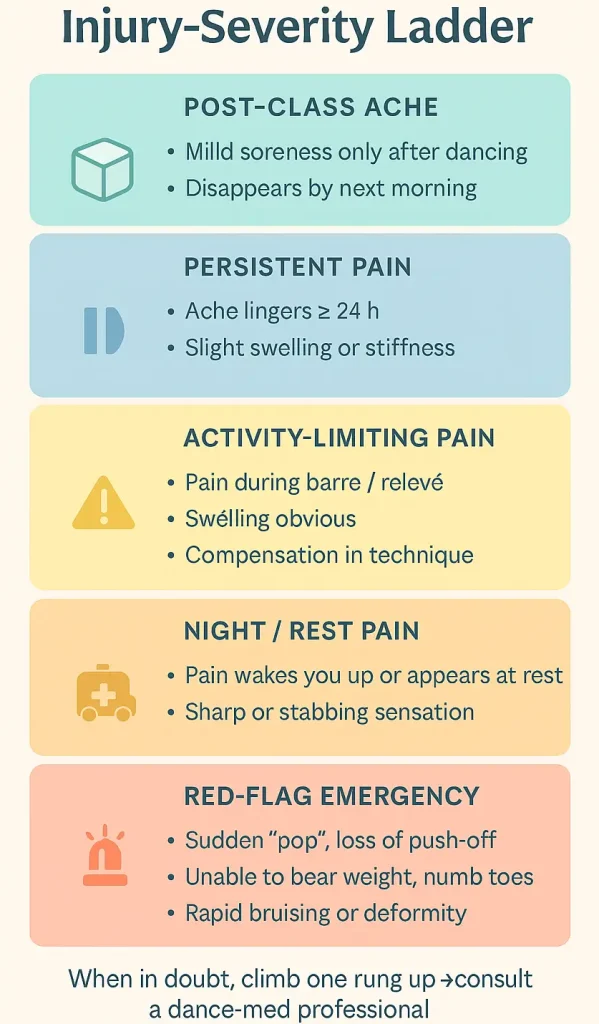
Resume
Ballet dancers face unique challenges in keeping their feet healthy. Understanding the causes of foot damage, recognizing early symptoms, and taking preventive measures are essential to ensuring a long and healthy career in ballet. Properly fitted pointe shoes, proper footwear, strengthening exercises, and adequate rest are crucial for preventing injuries.
Effective treatment options, including immediate care, professional medical treatments, and home remedies, can help manage foot injuries and support recovery. Regular check-ups with a podiatrist and seeking professional help for persistent or severe symptoms are vital for maintaining foot health. By following these guidelines, dancers can protect their feet and continue to perform at their best.
| Foot Issue | Description | Causes | Common Symptoms | Potential Consequences | Prevention & Management Strategies |
|---|---|---|---|---|---|
| Blisters | Fluid-filled lesions that form under or between layers of skin. | – Repetitive friction from pointe shoes and tights – Excessive moisture/sweat – Poorly fitting shoes | – Painful, fluid-filled bumps – Possible redness or swelling | – Infection risk if not treated properly – Chronic skin irritation | – Using properly fitted pointe shoes – Keeping feet dry with moisture-wicking materials – Applying protective padding or bandages – Properly caring for blisters (cleaning, covering) |
| Calluses & Corns | Thickened, hardened layers of skin (calluses on weight-bearing areas, corns on pressure points). | – Continuous pressure or friction – Repetitive pivoting or toe work | – Hardened or rough skin patches – Possible tenderness or pain | – Painful inflammation if left unattended – Potential skin breakdown | – Regular exfoliation (pumice stone) – Protective padding in problem areas – Proper footwear fitting – Professional pedicure or podiatry advice |
| Toenail Damage | Bruising, blackened nails, ingrown nails, and sometimes complete nail loss. | – Repetitive impact of toes in pointe shoes – Nail trauma from sudden forces – Improper nail trimming | – Discoloration or dark spots under the nail – Nail thickness changes – Pain at nail edges (ingrown nails) | – Loss of toenails or chronic nail deformities – Infection if bacteria enter under a damaged nail | – Trimming toenails straight across to prevent ingrown nails – Using properly fitting shoes with adequate toe space – Monitoring and treating bruised nails promptly |
| Bunions | Bony prominence at the base of the big toe (Hallux Valgus) that angles the toe inward. | – Genetic predisposition – Chronic pressure on the toe box, especially in tight pointe shoes – Faulty foot alignment and turnout | – A protruding bony bump at the side of the big toe – Redness or soreness – Toe misalignment | – Progressive deformity – Chronic pain and limited foot function | – Using toe spacers and bunion guards – Foot-strengthening exercises – Consulting with a podiatrist for orthotic or surgical interventions if severe |
| Metatarsalgia | Inflammation and pain in the ball of the foot, often under the 2nd or 3rd metatarsal. | – Excessive pressure on the metatarsal heads – High-impact dance steps – Inadequate arch support | – Sharp or burning pain in the ball of the foot – Pain that worsens with dancing | – Increased likelihood of stress fractures – Altered gait or technique due to pain | – Choosing shoes with sufficient shock absorption – Metatarsal pads or orthotics – Gradual training increases to avoid overload |
| Stress Fractures | Small cracks in bones (commonly in metatarsals) are due to repetitive stress rather than major trauma. | – Overtraining (excessive rehearsal) – Poor nutrition or low bone density – Repetitive high-impact landings | – Localized pain that intensifies with weight-bearing activity – Swelling or tenderness at the fracture site | – Potential for a full fracture if not managed – Long recovery periods that can interrupt training | – Adequate calcium & vitamin D intake – Structured training load progression – Using supportive footwear – Seeking medical evaluation for persistent pain |
| Ankle Sprains | Stretching or tearing of ligaments around the ankle, often the lateral (outer) ankle. | – Improper landings from jumps – Sudden twisting or rolling of the foot – Weakened or fatigued stabilizing muscles | – Swelling and bruising around the ankle – Pain and difficulty bearing weight | – Chronic ankle instability – Recurring injuries and possible tendon damage | – Consistent ankle-strengthening exercises – Proper warm-up and cool-down – Taping or bracing for additional support |
| Achilles Tendonitis | Inflammation of the Achilles tendon connecting the calf muscles to the heel bone. | – Overuse from excessive relevés, jumps – Tight calf muscles – Poor alignment or technique (overturning feet) | – Pain or stiffness in the back of the heel – Tenderness and swelling | – Tendon rupture if left untreated – Chronic pain and reduced range of motion | – Progressive strengthening & stretching of calves – Proper pointe technique & alignment – RICE (rest, ice, compression, elevation) for acute flare-ups |
| Plantar Fasciitis | Inflammation of the thick band of tissue running along the bottom of the foot (plantar fascia). | – Repeated stress on arches – Tight calf/foot muscles – Poor shock absorption | – Sharp heel or arch pain (often first steps in the morning) – Stiffness | – Chronic arch/heel pain – Reduced foot function or ability to perform certain dance movements | – Supportive insoles and taping – Calf and foot stretching exercises – Gradual increases in training intensity |
| Hammer Toes | Toe deformities are when the toes bend at the middle joint (commonly the second toe). | – Tight toe box or pointe shoe pressure – Imbalance in muscle function – Anatomical predisposition | – Noticeable toe bend – Calluses on the top or tip of the bent toe – Pain when wearing shoes | – Permanent deformity if not addressed – Difficulty finding comfortable footwear | – Toe exercises to strengthen and stretch – Wearing shoes with sufficient toe room – Use of splints or orthotics under professional guidance |
Frequently Asked Questions
What are common foot injuries in ballet dancers?
Ballet dancers frequently suffer from foot and ankle fractures, sprains, blisters, bunions, plantar fasciitis, and Achilles tendinitis, which can result from the intense physical demands of ballet.
How can I prevent foot damage while dancing ballet?
To prevent foot damage while dancing ballet, wear properly fitted pointe shoes, perform strengthening exercises, maintain good foot hygiene, and prioritize adequate rest and recovery. These steps are essential for protecting your feet from injury and enhancing your performance.
What should I do if I experience persistent foot pain?
If you experience persistent foot pain, you must consult a healthcare provider or physical therapist for a proper evaluation and to address any underlying issues. Taking action early can help prevent further complications.
What are the long-term effects of continuous ballet training on the feet?
Continuous ballet training can significantly alter foot shape and the shape of the heel bone, and may result in pronounced arches and chronic foot issues. It’s crucial to monitor foot health and address any discomfort promptly.
When should I seek professional help for foot injuries?
You should seek professional help for foot and ankle injuries if you experience chronic pain, significant swelling, deformities, or stress fractures, or if your symptoms persist despite self-care efforts. Timely intervention can lead to better outcomes.
What factors indicate a dancer is truly ready for pointe work?
Readiness is judged less by age alone and more by closed growth plates, four or more years of consistent ballet classes, sustained core and ankle strength, and the ability to maintain turnout without knee collapse; most orthopaedic guidelines still place the minimum age around 11–12, with some schools requiring an X-ray to confirm skeletal maturity.
How long can a pair of pointe shoes safely last?
For pre-professional dancers who train daily, a traditional pair often loses structural integrity in as little as 10–20 hours of class and rehearsal, while professionals may “kill” a pair in a single performance; once the shank softens or the toe-box deforms, the shoe no longer distributes force correctly and should be replaced.
What happens if you keep dancing in “dead” pointe shoes?
Worn shoes increase ankle sway, decrease joint space in the mid-foot, and shift body weight onto vulnerable metatarsals, dramatically raising the risk of sprains and stress injuries during relevé and sous-sus positions.
Can modern high-tech pointe shoes reduce injuries?
Shoes that incorporate polymer shanks and shock-absorbing foam, such as newer modular designs, maintain support far longer than paste-and-paper models, helping to cut cumulative impact forces and lower overuse-injury rates without altering external aesthetics for most repertoire.
Are custom orthotics or inserts useful inside pointe shoes?
Fully molded silicone or heat-form inserts can fill negative space in the toe-box, improve balance, and reduce pressure hotspots; dancers report greater comfort and fewer bruised toenails when inserts are individually cast to the foot instead of relying on generic toe pads.
Do male ballet dancers face different foot-injury patterns?
While women absorb more pointe-related stress, men sustain a higher proportion of metatarsal stress fractures and mid-foot sprains from repeated high-velocity landings, particularly during double tours and grands jetés.
Does joint hypermobility increase the risk of foot injuries?
Ankle and hip hypermobility are linked with higher rates of ligament sprains and overuse syndromes, underscoring the need for proprioceptive and strength work to stabilize excessively mobile joints.
How can nutrition and vitamin D protect a dancer’s bones?
Adequate calories, calcium, and vitamin D decrease the likelihood of early osteopenia and related stress fractures; many clinicians recommend periodic vitamin D checks for dancers who train indoors year-round.
What early signs suggest a developing stress fracture in the foot?
Localized swelling, pinpoint tenderness that intensifies with load, and night-time aching are red flags; ignoring them can let a stress reaction progress to a full fracture within weeks.
Which imaging method is most reliable for confirming foot injuries?
MRI detects bone-marrow edema and tiny cortical cracks before they appear on X-ray, making it the preferred modality for suspected stress injuries, followed by CT when detailed surgical planning is required.
What daily foot-care routine keeps skin and nails performance-ready?
Brief warm-water soaks, thorough drying, moisturizing the soles, trimming nails straight across, and disinfecting small blisters immediately help prevent fungal or bacterial infections and maintain healthy skin.
Are barefoot strengthening drills worth adding to class?
Targeted “toe-yoga” and elastic-band exercises performed out of shoes activate intrinsic muscles, support the arch, and can improve balance on pointe within about six weeks.
How does cross-training help prevent ballet foot injuries?
Resistance training, Pilates, and swimming offload overworked plantar flexors, correct muscle imbalances, and reduce overall injury incidence across a season.
What psychological challenges often accompany foot-injury recovery?
Dancers frequently experience shock, anxiety about casting changes, and fear of weight gain; structured mental-skills coaching and graded return-to-class plans correlate with faster emotional rebound.
When is it safe to return to pointe after a foot injury?
For uncomplicated low-risk stress fractures, most clinicians clear gradual barre work at six to eight weeks, progressing to full pointe only when pain-free hopping tests and imaging show solid healing.
Do injury patterns differ between students and seasoned professionals?
Students experience more acute ankle sprains, whereas professionals report higher rates of overuse pain and worse foot-specific quality-of-life scores despite better general health metrics.
How does dance-floor construction influence foot health?
Performing on unsprung stages or worn Marley significantly elevates ankle-joint stress and correlates with spikes in acute injuries; properly sprung subfloors disperse ground-reaction forces and reduce fatigue.
Which taping or padding techniques ease sesamoid pain?
A “dancer’s pad” with a central cut-out offloads the sesamoids, while spica taping keeps the big toe slightly plantar-flexed, limiting painful dorsiflexion during demi-pointe.

